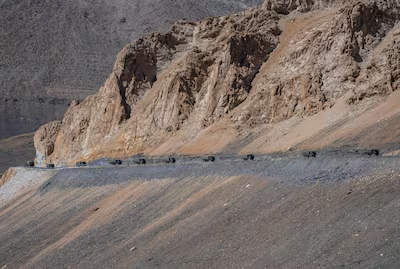Indian Prime Minister Narendra Modi and Chinese President Xi Jinping have agreed to prioritise efforts to de-escalate tension at their contested border.
The nuclear-powered nations share a nearly 4,000km border known as the Line of Actual Control (LAC) that crosses the Himalayas from the Ladakh region in the north to the eastern Indian state of Arunachal Pradesh. The frontier is not demarcated.
India’s Foreign Secretary Vinay Kwatra said Mr Modi held brief conversations with the leaders Brazil, China, Russia and South Africa on the sidelines of the two-day Brics summit in Johannesburg on Thursday.
In his conversation with Mr Xi, Mr Modi “highlighted India’s concerns on the unresolved issues” along the contested border.
Diplomatic ties between India and China have been frosty since their troops were involved in deadly clashes in 2020, along the part of the border that lies in the Ladakh region.
“Prime Minister Modi underlined the maintenance of peace and tranquillity in the border areas and observing and respecting the LAC are essential for normalising the India-China relationship,” Mr Kwatra told reporters.
“The two leaders agreed to direct their relevant officials to intensify efforts at expeditious disengagement and de-escalation.”

There have been several rounds of high-level talks between senior military commanders and Foreign Ministry officials from both sides but without significant progress.
The two nations held the 19th round of the India-China Corps Commander Level Meeting at the Chushul-Moldo border meeting point on the Indian side on August 13 and August 14.
They fought a deadly war over the disputed border in 1962, with Beijing briefly capturing parts of Arunachal Pradesh before unilaterally withdrawing its troops.
In June 2020, Indian and China soldiers armies attacked each other with iron rods and clubs in Ladakh’s Galwan Valley.
At least 20 Indian soldiers and four Chinese soldiers died fighting on pathways near steep cliff edges.
The clash triggered the mobilisation of tens of thousands of soldiers from both sides to the treacherous high-altitude border.
While the troops withdrew from a key area in the disputed Eastern Ladakh region in September, many other potential flashpoints remain.
Chinese forces continue to block access to traditional areas of patrol for the Indian military in the Depsang Plains and Charding Nala regions on the LAC.
The Depsang Plains are a plateau at an altitude of 4,800 metres. Chinese troops allegedly occupy an 18km area that India considers its own territory.
Beijing has consistently refused to accept those areas as Indian territory.





